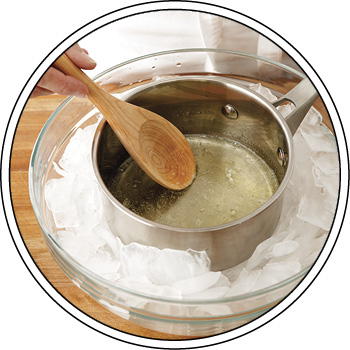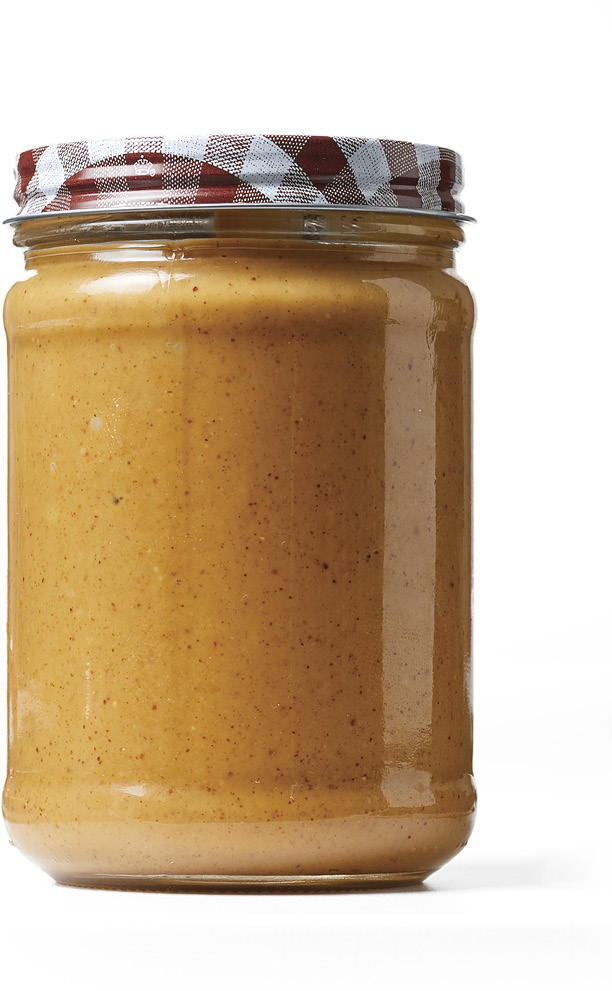key ingredients
These common ingredients appear often in our recipes. Here are the specifics about how each ingredient Is prepped in our test kitchen during testing.
nuts
Shelled nuts are sold in the supermarket baking aisle or bulk section. They are available whole, chopped (labeled “pieces”), roasted, salted, and sugared.
APPEARANCE
Look for shelled nuts that are plump and firm (not withered or rubbery) and uniform in color.
STORAGE
Nuts contain high amounts of oil and turn rancid quickly. Store nuts in tightly closed containers or bags in the freezer up to 8 months or pantry 1 to 2 months. Always taste before using.

GROUND NUTS
Use a blender or food processor to get this finer texture, adding 1 Tbsp. of the sugar or flour called for in the recipe for each cup of nuts. This absorbs some oil, keeping the nuts from clumping. Use on/off pulses to prevent overprocessing, which can result in a gooey nut butter.
TOAST FOR FLAVOR
Toasting nuts, seeds, and coconut adds depth of flavor. To toast nuts or coconut, spread evenly in a shallow pan and bake in a 350°F oven 5 to 10 minutes, stirring once or twice (watch closely). Toast seeds and finely chopped nuts in a dry skillet over medium heat, stirring often.
COARSELY CHOPPED
Use a chef’s knife to chop into large irregular pieces more than ¼ inch in size.
CHOPPED
Use a chef’s knife to chop into medium irregular pieces about ¼ Inch in size.
FINELY CHOPPED
Use a chef’s knife to chop into pieces about ⅛ inch in size.
crumbs & cubes

DRY BREAD CUBES
Crunchy bread cubes are used in stuffings and bread puddings. To make, stack a few bread slices and cut into ½-inch cubes. Bake cubes in a shallow baking pan in a 300°F oven 10 to 15 minutes or until dry and crisp, stirring twice; cool.
DRY BREAD CRUMBS
Fine dry bread crumbs can be purchased, or you can make your own. Use slightly stale dry bread slices or bake slices in a 300°F oven about 10 minutes or until slightly crisp. Use a food processor to make slightly coarse or fine crumbs. One slice yields ¼ cup fine dry crumbs.
SOFT BREAD CRUMBS
To create soft bread crumbs, cut fresh bread into cubes and pulse them in a food processor until crumbs form. One slice of bread, cubed and processed, yields ¾ cup crumbs.
PANKO CRUMBS
Look for panko bread crumbs at the supermarket with other breadings and coatings. They are light and crisp with a coarse texture. These crumbs work well for toppings, coatings, stir-ins, and any other dish where you would use traditional dry bread crumbs.
CRACKER CRUMBS
For 1 cup of cracker crumbs, use 28 saltine crackers, 24 rich round crackers, or 14 graham cracker squares. Pulse them in a food processor to desired fineness or crush them in a resealable plastic bag using a rolling pin.

cream cheese
Unless specified in the recipe, we test with regular cream cheese. However, we found that reduced-fat versions work equally well in most recipes. Avoid using fat-free cream cheese for cooking and baking—this product works best as a spread. To soften cream cheese, let stand at room temperature 30 minutes.
thickeners
Flour and cornstarch are the most common thickeners. To thicken 1 cup sauce to medium thickness, in a jar with a screw-top lid combine 2 Tbsp. flour with ¼ cup cold water or 1 Tbsp. cornstarch with 1 Tbsp. cold water. Shake it in the jar until well mixed (if in a bowl, whisk to combine ingredients). Stir into the sauce; cook and stir the sauce over medium heat until bubbly. To completely cook the starch, cook and stir 2 minutes more.

eggs
Recipes in this cookbook were developed and tested using large-size eggs.

Before adding eggs to a recipe, crack them into a separate bowl to make sure eggshells don’t end up in the food. To crack an egg, tap it on a flat countertop or on the rim of a bowl. If a piece of shell falls into the raw egg, use a spoon to scoop it out.

PASTEURIZING EGG WHITES
For food safety, start with purchased pasteurized egg whites when recipes use raw egg whites that are never cooked. Or follow these steps to pasteurize them yourself. In a 1- or 1½-qt. saucepan stir together 2 egg whites, 2 Tbsp. sugar, 1 tsp. water, and ⅛ tsp. cream of tartar just until combined but not foamy. Heat and stir over low heat until mixture registers 160°F. (Don’t worry if you notice a few small bits of cooked white in the mixture.) Remove from heat and place saucepan in a large bowl half-filled with ice water. Stir 2 minutes to cool quickly.

salt
Unless noted, our recipes are tested with iodized table salt. Here are tips for using specialty salts.
FLEUR DE SEl
This pricey salt is used to finish a dish, adding a mild but distinct flavor. Sprinkle lightly on salads, rich chocolate or caramel desserts, and before serving meats and fish.
MALDON
This popular flaked sea salt is made from purified seawater from the shores of Essex, England. It has a pyramid shape and delightfully briny flavor. Sprinkle over delicately flavored food just before serving.
KOSHER SALT
This salt, a favorite with chefs, usually has no additives (such as iodine). Each grain is large and flat, so kosher salt dissolves quickly and can be added at any stage of the cooking process. Because of its size, 1 tsp. kosher salt contains less sodium than 1 tsp. table salt.
sugar
Most sugar bowls are filled with granulated (white) sugar. The finely textured crystals are easy to measure and dissolve quickly. Powdered sugar is very finely ground, combined with an anticaking agent, and sifted. Other sugars, including blond-color raw turbinado and light and dark brown sugars, give a molasses sweetness to recipes. For information on baking with sugar, see Sugars & sweeteners.


flour
Wheat flour is the most common flour used in cooking. All-purpose wheat flour has a moderate protein content and is available both bleached and unbleached. Bread flour (also wheat), in comparison, has a higher protein content for sturdier foods like crusty breads, rolls, and pizza doughs. For information on flour and for our Gluten-Free Flour Mix.
oats & oatmeal

OAT GROATS
The least-processed option, groats (hulled, unbroken oat grains) can be cooked and served as a cereal and prepared like rice for a side dish or salad.
STEEL-CUT OATS
Also called Irish or Scottish oats, these coarse oats are made by chopping groats into smaller pieces. They require longer cooking than rolled and quick-cooking oats and are chewier.
ROLLED OATS
Rolled oats (aka old-fashioned) are whole groats that have been hulled, steamed, and flattened. They cook faster than steel-cut. (To toast, stir in a dry skillet over medium heat until golden brown.)
QUICK-COOKING ROLLED OATS
This version is made from groats that have been chopped before undergoing the steaming process. They are flattened more than rolled oats, so they cook faster and are less chewy.
INSTANT OATS
Instant oats are precooked (which makes them super soft) and dried before they are flattened with rollers. They cook extra fast for breakfast but don’t work well in baked goods.
OAT FLOUR
Oat flour is made by grinding gluten-free oats. But contamination can occur during grinding, so it isn’t considered a gluten-free substitute for wheat. If you bake with it, experiment by substituting small amounts.
OAT BRAN
Bran is the outer coating of the grain and is packed with soluble fiber. You can add it to baked goods to increase the fiber content. Experiment by starting with small amounts.

MILK
During testing, we always use reduced-fat (2%) dairy milk (unless otherwise noted in the ingredient list). In many recipes, any milk will work—even nondairy milks—but the richness of the product may be affected. Nondairy milks made from soy, almond, rice, coconut, cashew, macadamia, oat, and hemp are located alongside refrigerated dairy milk. Shelf-stable options are also available. Some brands offer unsweetened and sweetened milks along with added flavors, especially vanilla. Use your judgment when swapping (i.e., sweetened vanilla-almond milk is a good choice for a fruit smoothie; unsweetened plain soymilk is better for sauces). Use only dairy milk for custards and puddings.
broth
When the sodium level of a recipe (specifically for soups and stews) gets too high, our Test Kitchen balances it by using reduced-sodium or no-salt-added broth. Stock and bone broth products are also available and work as substitutes for regular broth. Broth bases, granules (bouillon), and concentrates can be used for sauces or soups and as seasoning for rice and boiled potatoes as they cook. Adjust other seasonings as necessary depending on the sodium in the product you use.

peanut butter
The market is filled with peanut butter choices. Most versions rely on shelf-stable oils—such as palm oil—for a smooth, evenly blended consistency that doesn’t separate at room temperature. This is the type we use to test all of our recipes. Some peanut butter varieties, labeled as “natural,” just use peanuts and peanut oil and require refrigeration. These types tend to separate upon standing and require stirring. It can be difficult to fully blend them for an even consistency, which may affect cooking and baking results.

oils
These are the most common oils and their uses. (Smoke point: how hot an oil can get before it starts to smoke.)
Canola
Smoke point 400°F
A mild flavor and medium smoke point make canola a good all-purpose oil. Use for all baking and cooking tasks.
Coconut
Smoke point 350°F–400°F
Refined coconut oil has a very mild coconut flavor and a higher smoke point (400°F); unrefined has a stronger coconut taste and lower smoke point (350°F). It is a solid at room temp and below.
Corn
Smoke point 450°F
Its high smoke point and neutral flavor make this oil an excellent choice for frying, baking, and cooking.
Olive
Smoke point 325°F–410°F
Unprocessed extra virgin olive oil has a strong olive flavor (almost grassy or fruity) and a lower smoke point (325°F). Use it as a dipping oil or a vinaigrette base. Pure olive oil is a combination of refined and extra virgin oils filtered for light flavor and a higher smoke point (410°F).
Peanut
Smoke point 450°F
This is the go-to oil for deep-fat frying and stir-frying.